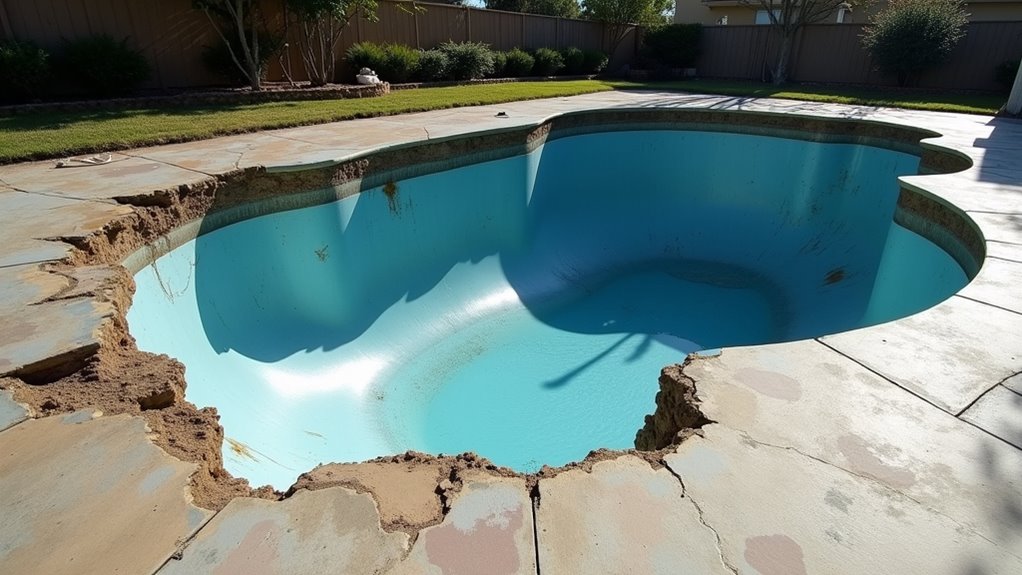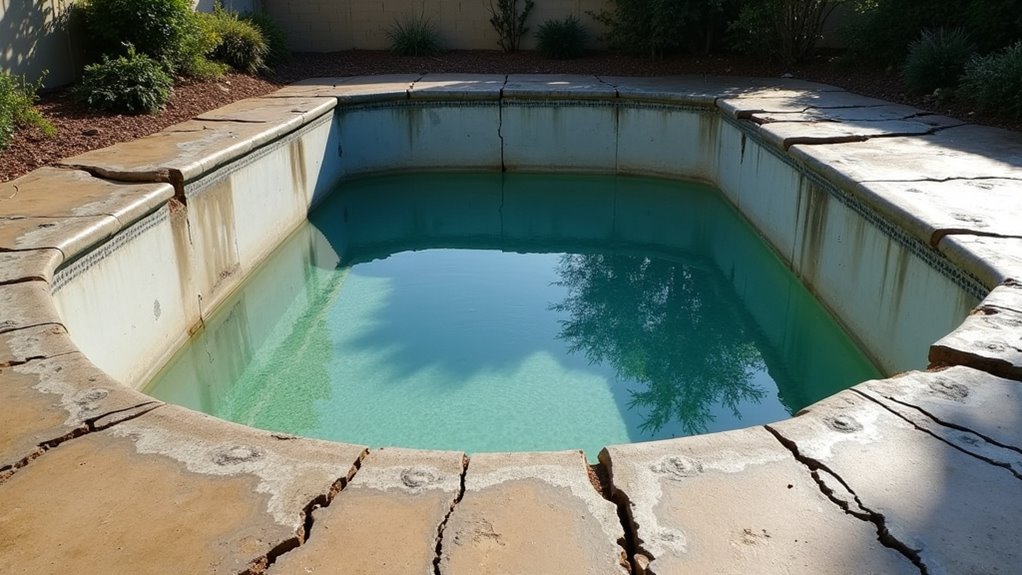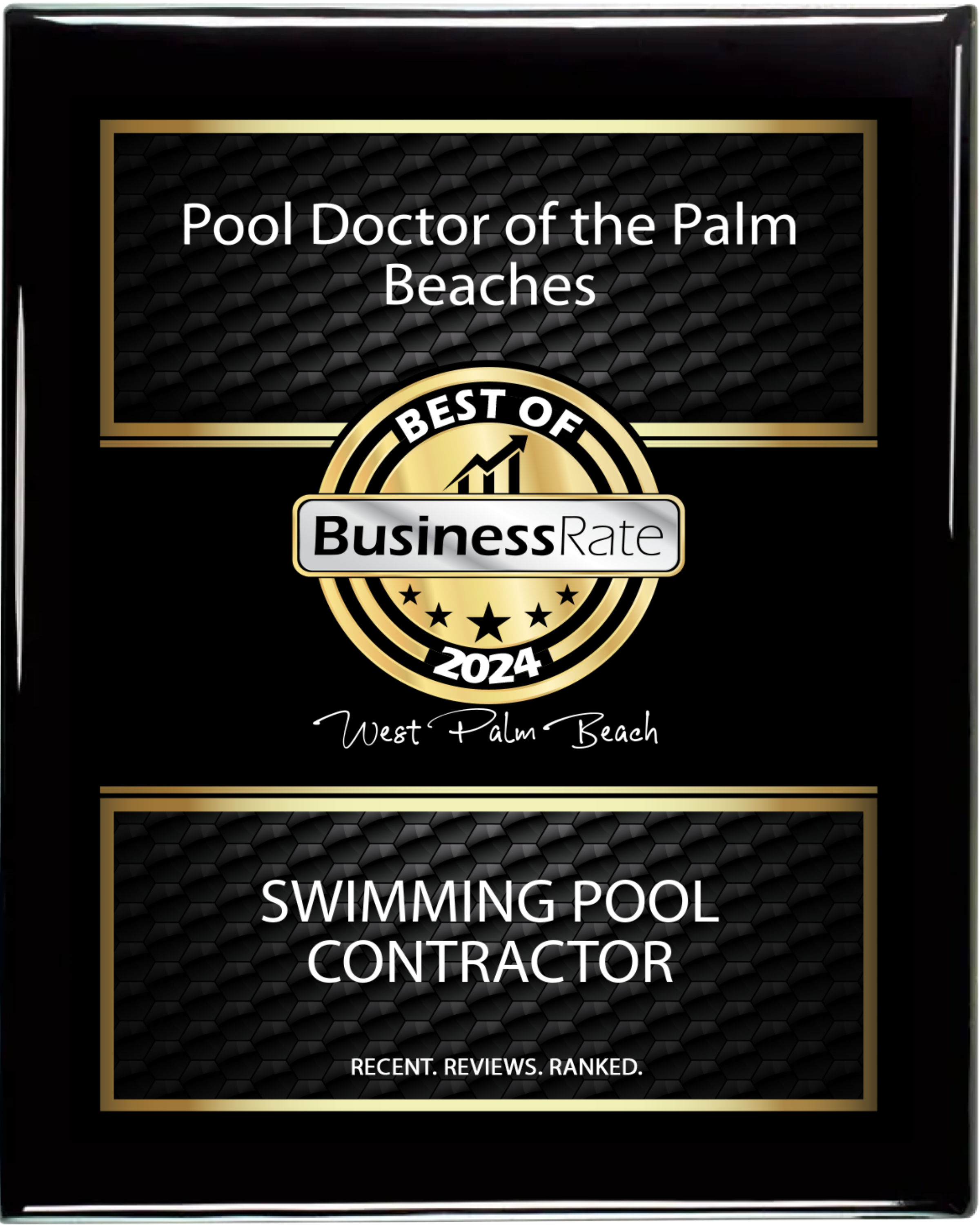You shouldn’t completely drain your swimming pool because groundwater pressure beneath the shell can force the entire structure to pop out of the ground like a cork. This hydrostatic pressure creates dangerous uplift conditions that can crack walls, separate foundations, and cause extensive structural damage costing tens of thousands in repairs. Even with hydrostatic relief valves, empty pools remain vulnerable to this destructive force. Understanding the complex dynamics of pool structure management can help prevent catastrophic failure.
Key Takeaways
- Groundwater pressure beneath an empty pool can force the shell upward, causing severe structural damage and costly repairs.
- Empty pools lose their counter-pressure against underground water, creating dangerous uplift conditions that can “pop” the pool.
- High water tables and heavy rainfall increase the risk of pool popping when a pool is drained completely.
- Hydrostatic relief valves may fail or clog over time, making complete draining especially risky for older pools.
- The cost of repairing a popped pool can reach tens of thousands of dollars due to extensive structural damage.
Understanding Pool Popping: The Hidden Danger Below

What happens when groundwater pressure meets an empty pool shell? The result is a destructive phenomenon called “pool popping,” where hydrostatic pressure forces your pool out of the ground like a cork.
During pool construction, builders install hydrostatic relief valves to manage groundwater pressure. However, these valves can fail or become clogged over time. When you drain your pool completely, you remove the water weight that counterbalances the upward force of groundwater beneath the shell. This pressure differential can cause catastrophic damage, lifting your pool several inches or even feet above ground level.
The risk increases considerably in areas with high water tables or after heavy rainfall. Once a pool pops, you’re facing extensive structural repairs, potential deck damage, and plumbing system failures that can cost tens of thousands of dollars to fix.
How Hydrostatic Pressure Affects Your Pool Structure

While many pool owners focus on water pressure inside their pools, the external hydrostatic pressure exerted by groundwater presents a vital structural concern. This force acts continuously against your pool’s shell, affecting its structural integrity and pool stability.
When groundwater levels rise, you’ll encounter these vital effects:
- Upward pressure increases beneath your pool floor, potentially causing lifting or separation from the foundation
- Lateral forces intensify against pool walls, which can lead to cracking or bowing of the structure
- Pressure differential between empty pool and surrounding soil creates dangerous uplift conditions
- Relief valves and hydrostatic plugs may become compromised, reducing their effectiveness in managing pressure
Understanding these hydrostatic pressure dynamics is essential for maintaining your pool’s structural integrity and preventing costly damage.
Warning Signs That Your Pool Is at Risk

Recognizing the early indicators of hydrostatic pressure damage can prevent catastrophic pool failure. Watch for cracks in your pool’s surface, particularly along the floor and lower walls. You’ll notice these fissures starting small but gradually expanding if left unchecked.
Pay attention to unexplained pool leaks that persist even after routine maintenance. If your water level drops more than 1/4 inch daily, you’re likely facing structural issues. Monitor your water balance carefully; sudden changes in chemical readings might indicate groundwater infiltration through developing cracks.
Other warning signs include bulging or buckling of the pool floor, tiles popping loose without explanation, and unusual sounds coming from the shell structure. If you spot any of these indicators, especially after heavy rainfall, contact a pool professional immediately for assessment.
Safe Water Level Management Techniques
Because proper water level management is essential for pool structural integrity, you’ll need to maintain ideal levels throughout all seasons. Monitor your pool’s water level regularly and implement these maintenance tips to protect your investment:
- Keep water levels at mid-skimmer height (approximately 4-6 inches below the pool deck) to guarantee optimal circulation and prevent structural stress
- Install an auto-fill device with precise calibration to maintain consistent water levels, especially during high-evaporation periods
- During heavy rain events, drain excess water until it reaches the mid-skimmer mark to prevent overflow and deck damage
- In winter regions, maintain water levels 2-3 inches lower than normal to accommodate freezing expansion while guaranteeing the pool remains sufficiently full to resist groundwater pressure
When Partial Draining Is Necessary and How to Do It
Although complete draining should be avoided, certain pool maintenance tasks require partial draining to guarantee peak functionality and safety. You’ll need to lower the water level when repairing tiles, replacing coping, or addressing structural issues near the waterline.
To partially drain your pool, use a submersible pump and reduce the water level to just below the area requiring maintenance. Monitor the water chemistry closely during this process, as partial draining can affect chemical balance. Once you’ve completed the repairs, refill the pool immediately with fresh water to prevent structural stress.
For best results, perform partial draining during mild weather conditions and never leave the pool at a reduced water level for more than 24 hours. Remember to recalibrate your pool’s chemical balance after refilling to maintain proper water chemistry.
Professional Solutions for Major Pool Repairs
Major pool repairs demand professional expertise and specialized equipment that most homeowners don’t possess. When you’re facing significant structural issues or planning a thorough pool renovation, it’s essential to enlist certified pool contractors who understand advanced repair techniques.
Professional pool specialists offer these essential services:
- Structural integrity assessment using specialized scanning equipment to detect hidden cracks and potential failure points
- Advanced repair techniques for shell delamination, including epoxy injection and fiberglass reinforcement
- Professional-grade resurfacing with specialized materials like quartz aggregate or pebble finishes
- Extensive plumbing system diagnostics and repairs using leak detection technology
These experts also maintain proper insurance coverage and understand local building codes, ensuring your pool renovation meets all safety and regulatory requirements while protecting your investment.
Preventive Measures to Protect Your Pool Investment
While maintaining your pool might seem like a routine task, implementing strategic preventive measures can greatly extend its lifespan and protect your substantial investment. You’ll need to establish a consistent pool maintenance schedule that prioritizes water chemistry balance and structural integrity.
| Action | Benefit |
|---|---|
| Weekly pH testing | Prevents surface erosion |
| Monthly stabilizer checks | Maintains chlorine effectiveness |
| Quarterly equipment inspection | Identifies potential failures |
| Annual structural assessment | Detects early damage signs |
Keep detailed records of your water chemistry readings and maintenance activities. Monitor your pool’s water level, ensuring it doesn’t drop below the skimmer line, as this can damage your pump system. Install a quality pool cover to minimize evaporation and debris accumulation, and regularly inspect your pool’s surface for any signs of wear or damage.
Frequently Asked Questions
Can I Drain My Pool During Freezing Temperatures?
You shouldn’t drain your pool during freezing temperatures as part of your winter preparation or pool maintenance routine. When water freezes, it expands and can cause severe damage to your pool’s plumbing, equipment, and structural components. Instead, you’ll want to maintain proper water levels slightly below the skimmer opening, use pool-specific antifreeze in the plumbing lines, and install a winter cover to protect your investment during cold weather.
How Long Can I Safely Keep My Pool Empty?
For ideal pool maintenance and safety, you shouldn’t keep your pool empty for more than 1-2 days maximum. When your pool remains empty longer, you’re risking structural damage, liner shrinkage, and seal deterioration. If you’re planning essential repairs, schedule them efficiently to minimize empty time. You’ll want to refill quickly to maintain the pool’s structural integrity and prevent potential damage to plumbing systems and surface materials.
Will Pool Insurance Cover Damage From Improper Draining?
Your pool insurance policy likely won’t cover damage resulting from improper draining, as most insurers consider this preventable damage due to negligence. Standard damage coverage typically excludes issues caused by improper maintenance or DIY mistakes. You’ll need to carefully review your policy’s specific exclusions, but generally, you’re responsible for damages caused by incorrect draining procedures. It’s best to consult your insurance provider and a licensed pool professional before undertaking any major draining work.
Does Vinyl Liner Pool Popping Occur Differently Than Concrete Pools?
Yes, vinyl liner pools experience popping differently than concrete pools due to their distinct structural characteristics. While concrete pools rely on their mass and concrete stability to resist hydrostatic pressure, your vinyl pool’s durability depends on the flexible liner and supporting wall structure. You’ll find that vinyl pools are more susceptible to shifting and deformation when drained, as they don’t have the inherent weight and rigid composition that concrete pools possess.
Can Installing Additional Hydrostatic Valves Prevent Pool Popping After Construction?
While you can install supplementary hydrostatic valves after construction, they won’t guarantee complete protection against pool popping. The effectiveness depends on proper valve placement and your pool’s specific groundwater conditions. You’ll need to carefully consider the existing hydrostatic pressure points and soil composition. For best results, consult a pool engineering specialist who can assess your site’s conditions and determine ideal valve installation locations in your pool’s structure.



